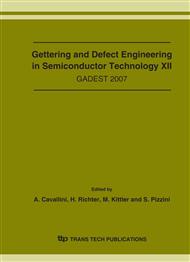p.1
p.9
p.15
p.21
p.27
p.33
p.39
Impact of Iron and Molybdenum in Mono and Multicrystalline Float-Zone Silicon Solar Cells
Abstract:
This paper investigates the impact of iron (Fe) and molybdenum (Mo) when they are introduced in the feedstock for mono- and multicrystalline Float-Zone (FZ) silicon (Si) growth. Neutron Activation Analysis shows that the segregation coefficient is in agreement with literature values. Lifetime maps on monocrystalline wafers show a uniform lifetime which decreases with the increase of contamination levels. Multicrystalline wafers show low lifetime areas, corresponding to grain boundaries and highly dislocated areas, which are independent from the contamination levels. Intra grain areas have a higher lifetime which changes with the contamination levels. The solar cells show a reduced diffusion length in multicrystalline uncontaminated cells compare to the monocrystalline uncontaminated. In multicrystalline cells the lowest level of Fe introduced (1012 atm/cm3) has hardly any influence, whereas in the Mo-contaminated cells the impact is visible from the lowest level (1011 atm/cm3). In monocrystalline cells the diffusion length is reduced already at the lowest contamination level of Fe.
Info:
Periodical:
Pages:
15-20
Citation:
Online since:
October 2007
Keywords:
Price:
Сopyright:
© 2008 Trans Tech Publications Ltd. All Rights Reserved
Share:
Citation:


